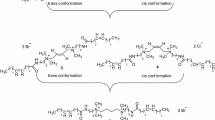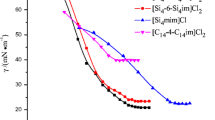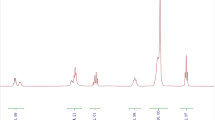Abstract
In this work, succinic gemini surfactants, dl- and meso-2,3-bis(alkyl)succinic acids (alkyl: C6H13–C13H27), were successfully synthesized by oxidative coupling of enolates of fatty acid tert-butyl esters with copper(II) bromide followed by treatment with CF3COOH. Focusing on the influence of stereochemistry (dl- and meso-) of succinic geminis, their monolayer behaviors at the air–water interface were explored using surface pressure–area (Π–A) isotherms, the compression modulus of monolayers (ε s), and Brewster angle microscope (BAM) analysis. meso-2,3-Bis(undecyl)succinic acid showed a unique isotherm where the surface pressure drastically decreased at A = ~0.56 nm2 (Π = 21.9 mN m−1) regardless of compression rates and subphase temperatures, while dl-isomer showed the common isotherm of gas → liquid-expanded → liquid-condensed phase transitions. BAM analysis on meso-2,3-bis(undecyl)succinic acid films at the air–water interface showed that small islands of aggregates appear just after the maximum pressure (A = ~0.56 nm2), and on further compression needle-shaped assemblies appear that can grow in size. It was reasonably concluded that hydrophobic interactions can operate more effectively in meso-isomers than in dl-isomers, and that meso-molecules can “jump up” to cause a transition from monolayer to bilayer. This is the first finding of the “jumping-up” phenomenon of gemini surfactants having meso-stereochemistry.






Similar content being viewed by others
References
Menger FM, Littau CA (1991) Gemini-surfactants: synthesis properties. J Am Chem Soc 113:1451–1452. doi:10.1021/ja00004a077
Menger FM, Keiper JS (2000) Gemini surfactants. Angew Chem Int Ed 39:1906–1920. doi:10.1002/1521-3773(20000602)39:11%3C1906::AID-ANIE1906%3E3.0.CO;2-Q
Hait SK, Moulik SP (2002) Gemini surfactants: a distinct class of self-assembling molecules. Curr Sci 82:1101–1111. http://www.iisc.ernet.in/currsci/may102002/1101.pdf
Zana R (2002) Dimeric and oligomeric surfactants. Behavior at interfaces and in aqueous solution: a review. Adv Colloid Interface Sci 97:205–253. doi:10.1016/S0001-8686(01)00069-0
Zana R, Xia J (2004) Gemini surfactants: synthesis, interfacial and solution-phase behavior, and applications. Surfactant Science Series 117, Marcel Dekker, New York. doi:10.1201/9780203913093
Hana Y, Wang Y (2011) Aggregation behavior of gemini surfactants and their interaction with macromolecules in aqueous solution. Phys Chem Chem Phys 13:1939–1956. doi:10.1039/c0cp01196g
Kumara N, Tyagi R (2014) Industrial applications of dimeric surfactants: a review. J Disper Sci Technol 35:205–214. doi:10.1080/01932691.2013.780243
Zhu Y-P (2004) Structure-performance relationships in gemini surfactants. Surfactant Science Series 117, Marcel Dekker, New York, pp 281–300. doi:10.1201/9780203913093
Franses EI, Prosser AJ, Infante MR, Perez L, Pinazo A (2004) Adsorption and surface tension behavior of gemini surfactants at air–water, oil–water, and solid–water interfaces. Surfactant Science Series 117, Marcel Dekker, New York, pp 65–92. doi:10.1201/9780203913093
Tyagi P, Tyagi R (2009) Synthesis, structural properties and applications of gemini surfactants: a review. Tenside Surf Det 46:373–382. doi:10.3139/113.110045
Sommerdijk NAJM, Hoeks THL, Synak M, Feiters MC, Nolte RJM, Zwanenburg B (1997) Stereodependent fusion and fission of vesicles: calcium binding of synthetic gemini phospholipids containing two phosphate groups. J Am Chem Soc 119:4338–4344. doi:10.1021/ja962303s
Bello C, Bombelli C, Borocci S, di Profio P, Mancini G (2006) Role of the spacer stereochemistry on the aggregation properties of cationic gemini surfactants. Langmuir 22:9333–9338. doi:10.1021/la061230f
Caracciolo G, Pozzi D, Mancini G, Caminiti R (2007) Role of the spacer stereochemistry on the structure of solid-supported gemini surfactants aggregates. Langmuir 23:10040–10043. doi:10.1021/la7014995
Luchetti L, Mancini G (2000) NMR investigation on the various aggregates formed by a gemini chiral surfactant. Langmuir 16:161–165. doi:10.1021/la990713z
Sugiyasu K, Tamaru S, Takeuchi M, Berthier D, Huc I, Oda R, Shinkai S (2002) Double helical silica fibrils by sol-gel transcription of chiral aggregates of gemini surfactants. Chem Commun 2002:1212–1213. doi:10.1039/B202799M
Shankar BV, Patnaik A (2007) A new pH and thermo-responsive chiral hydrogel for stimulated release. J Phys Chem B 111:9294–9300. doi:10.1021/jp073275a
Shankar BV, Patnaik A (2007) Chiral discrimination of a Gemini-type surfactant with rigid spacer at the air–water interface. J Phys Chem B 111:11419–11427. doi:10.1021/jp074279i
Shankar BV, Patnaik A (2008) Equilibrium structure and dynamics of (2R,3R)-(+)-bis(decyloxy)succinic acid at the air–water interface. Langmuir 24:758–766. doi:10.1021/la701998c
Shankar BV, Patnaik A (2008) Chiral cones and vesicles from Gemini-type fatty acid-heteroditopic amine mixtures. Soft Matter 4:1713–1717. doi:10.1039/b802425a
Zoubir E-H, Mancini G, Ribo JM, Sorrenti A (2010) Propagation of chirality from gemini surfactants to porphyrin/surfactant heteroaggregates: transcription of the stereochemical information into an organizational feature. New J Chem 34:260–266. doi:10.1039/B9NJ00282K
Liang Y, Hu Z, Cao D (2014) Surface adsorption and aggregation properties of novel l-lysine-based gemini surfactants. J Surf Det 17:693–701. doi:10.1007/s11743-013-1541-6
Harvey N, Rose P, Porter NA, Huff JB, Arnett EM (1988) Monolayer properties of eight diastereomeric two-chain surfactants at air/water interface: a resultant of intramolecular and intermolecular forces. J Am Chem Soc 110:4395–4399. doi:10.1021/ja00221a046
Porter NA, Ok D, Huff JB, Adams CM, McPhail AT, Kim K (1988) Equilibration of diastereomeric two-chain surfactants. Hydrophobic control of organic stereochemistry. J Am Chem Soc 110:1896–1901. doi:10.1021/ja00214a038
Buijnsters PJJA, Rodriguez CLG, Willighagen EL, Sommerdijk NAJM, Kremer A, Camilleri P, Feiters MC, Nolte RJM, Zwanenburg B (2002) Cationic gemini surfactants based on tartaric acid: synthesis, aggregation, monolayer behavior, and interaction with DNA. Eur J Org Chem 2002:1397–1406. doi:10.1002/1099-0690(200204)2002:8%3C1397::AID-EJOC1397%3E3.0.CO;2-6
Ryhanen SJ, Pakkanen AL, Säily MJ, Bello C, Mancini G, Kinnunen PKJ (2002) Impact of the stereochemical structure on the thermal phase behavior of a cationic gemini surfactant. J Phys Chem B 106:11694–11697. doi:10.1021/jp015623t
Silva SG, Fernandes RF, Marques EF, Vale MLC (2012) Serine-based bis-quat gemini surfactants: synthesis and micellization properties. Eur J Org Chem 2012:345–352. doi:10.1002/ejoc.201101118
Pinazo A, Pons R, Perez L, Infante MR (2011) Amino acids as raw material for biocompatible surfactants. Ind Eng Chem Res 50:4805–4817. doi:10.1021/ie1014348
Moran C, Perez L, Pons R, Pinazo A, Infante MR (2010) Amino acids, lactic acid and ascorbic acid as raw materials for biocompatible surfactants. In: Kjellin M, Johansson I (eds) Surfactants from renewable resources, Wiley, Chichester. doi:10.1002/9780470686607.ch5
Menger FM, Mbadugha BNA (2001) Gemini surfactants with a disaccharide spacer. J Am Chem Soc 123:875–885. doi:10.1021/ja0033178
Pestman JM, Terpstra KR, Stuart MC et al. (1997) Nonionic bolaamphiphiles and gemini surfactants based on carbohydrates. Langmuir 13:6857–6860. doi:10.1021/la970681k
Nakanishi F, Minamikawa H (1990) Langmuir-Blodgett films of diastereomeric tartaric acid derivatives. Sen’i Gakkaishi 46:409–411. doi:10.2115/fiber.46.9_409
Kawase T, Saito I, Oida T (2011) Effects of hydrophobic chain length on temperature dependence of monolayer behavior of ester-type tartaric geminis. J Oleo Sci 60:61–69. doi:10.5650/jos.60.61
Kawase T, Saito I, Oida T (2013) Monolayer behavior of asymmetrical ester type tartaric gemini. J Oleo Sci 62:371–380. doi:10.5650/jos.62.371
Aisaka T, Oida T, Kawase T (2007) A novel synthesis of succinic acid type Gemini surfactant by the functional group interconversion of corynomicolic acid. J Oleo Sci 56:633–644. doi:10.5650/jos.56.633
Quermann R, Meletz R, Schafer H (1993) Conversion of fatty acid methyl esters into dialkylated succinic esters by oxidative coupling of their enolates. Liebigs Ann Chem 1993:1219–1223. doi:10.1002/jlac.19931991011977
Andrés JM, Pedrosa R, Pérez A, Pérez-Encabo A (2001) Diastereoselective synthesis of enantiopure γ-amino-β-hydroxy acids by Reformatsky reaction of chiral α-dibenzylamino aldehydes. Tetrahedron 57:8521–8530. doi:10.1016/S0040-4020(01)00804-3
Kajiyama T, Morimoto N, Uchida M, Oishi Y (1989) Static viscoelastic characteristics-aggregation structure relationships of monolayers at air–water interface. Chem Lett 18:1047–1050. doi:10.1246/cl.1989.1047
Kajiyama T, Oishi Y, Uchida M, Morimoto N, Ishikawa J, Tanimoto Y (1992) Evaluation of melting and crystalline relaxation temperatures of fatty acids monolayers on the water surface and their importance for molecular aggregation states in monolayers. Bull Chem Soc Jpn 65:864–870. doi:10.1246/bcsj.65.864
Vollhardt D, Siegel S, Cadenhead DA (2004) Characteristic features of hydroxystearic acid monolayers at the air/water interface. J Phys Chem B 108:17448–17456. doi:10.1021/jp048304l
Neimert-Andersson K, Blomberg E, Sornfai P (2004) Stereoselective synthesis of polyhydroxy surfactants. Stereochemical influence on langmuir monolayers. J Org Chem 69:3746–3752. doi:10.1021/jo0357566
Acknowledgments
Mr. Mitsuya Kouno at the Advanced Technology Center of the Kyoto Institute of Technology is thanked for performing the elemental analysis.
Author information
Authors and Affiliations
Corresponding author
About this article
Cite this article
Kawase, T., Kagawa-Ohara, M., Aisaka, T. et al. Synthesis of Succinic Gemini Surfactants and the Effect of Stereochemistry on Their Monolayer Behaviors. J Surfact Deterg 18, 615–627 (2015). https://doi.org/10.1007/s11743-015-1682-x
Received:
Accepted:
Published:
Issue Date:
DOI: https://doi.org/10.1007/s11743-015-1682-x




